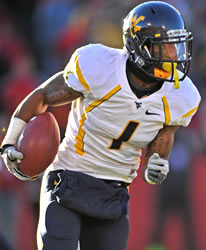
Austin: The next Randall Cobb?
Vitals
Height/Weight: 5’8/174
Hands: 9 1/8”
Important NFL Combine Numbers
40-Yard Dash: 4.34
Vertical Jump: 34”
Broad Jump: 10’
20-Yard Shuttle: 4.01
Background (College Stats)
A two-time Maryland high school player of the year that set a number of state career and single-season records, Austin led the NCAA in all-purpose yards as a junior (198/game) and finished second in the category as a senior (224.4). Austin was already in consideration to be a potential late-first or early-second round draft pick midway through last season, but likely solidified his standing as a top-20 selection with a historic performance against Oklahoma on Nov. 17, 2012. In that contest, Austin – a wide receiver who had no more than five carries in any of his first 48 career games – rushed 21 times for a school-record 344 yards in his first action at running back since high school and set a Big 12 record with 572 all-purpose yards. As a result of his stellar senior season, Austin won the Paul Hornung Award (most versatile player) and earned first-team All-America honors as an all-purpose player.
NFL Player Comp(s): Randall Cobb / T.Y. Hilton
Strengths
Austin combines incredible acceleration with breathtaking quickness, allowing him to be the kind of “space player” the NFL has found a role for in recent years. Perhaps the one aspect of his game that really jumps off the tape is his stop-and-start ability which – when combined with his body control and vision in the open field – allows him to create a lot of “whiffs” and make defenders look silly. These same qualities obviously bode well for his chances to be one of the NFL’s top kickoff and punt returners – areas in which he excelled in college. While his size will likely always be an issue, defenders rarely get a chance to square up Austin – particularly in the open field – and, as such, he never missed a practice or game at West Virginia. That quality, along with the fact that he plays to his timed speed, should help quickly dissolve the notion that he is a slot-only receiver with return skills. Austin gains separation rather easily, has a solid feel for the soft areas in zone coverage and transitions out of cuts effortlessly. Although he wasn’t used much as a deep threat in college, he certainly has the ability to do that and will fight for the ball in the air.
Weaknesses
Size – and how it relates to his ability to absorb punishment in the NFL – is probably always going to be the biggest question mark with Austin. He isn’t the most consistent “hands-catcher” and will drop balls that he should catch. On the rare occasion that he can’t make a defender miss, he tends to get tripped up easier than he should. Austin often plays as if he has gotten used to defenders being unable to corral him – which could easily come back to haunt him at the next level. His vertical jump is average for a receiver – which accentuates his lack of height even more – meaning quarterbacks probably won’t throw to him as much down the field despite his top-end speed unless he has at least a step or more on his defender.
Bottom Line
Austin isn’t built in the same way Percy Harvin is – and probably never will be – which will likely result in him being used slightly less on offense than he should be, at least initially. The upside for his future employer is that while he may only see 30-40 snaps on offense per game in his first season or two, his contributions as a returner may help make for it. In that way, it is entirely possible that his career trajectory is similar to Cobb’s in which he essentially forces his way into the starting lineup in Year 2 simply because he will prove to be his team’s most explosive playmaker. As is usually the case with a young skill-position player entering the league, the creativity, aggressiveness and scheme of the offense he enters will have a big say in his overall production. His best fit will likely be in a wide-open passing offense that uses him all over the field and isn’t scared of how someone of his size will hold up long-term. Austin projects better to the NFL than a similar-sized player such as Dexter McCluster simply because he is more elusive and explosive. While Austin could line up in the backfield in theory to dictate defensive personnel, it would be a mistake for his future team to put him in a position where he may be forced to run in between the tackles. Austin is a slot receiver that should hold his own on the outside in two-receiver packages and contribute as a returner, not a receiver that should be asked to serve in a third-down back role at any cost.
